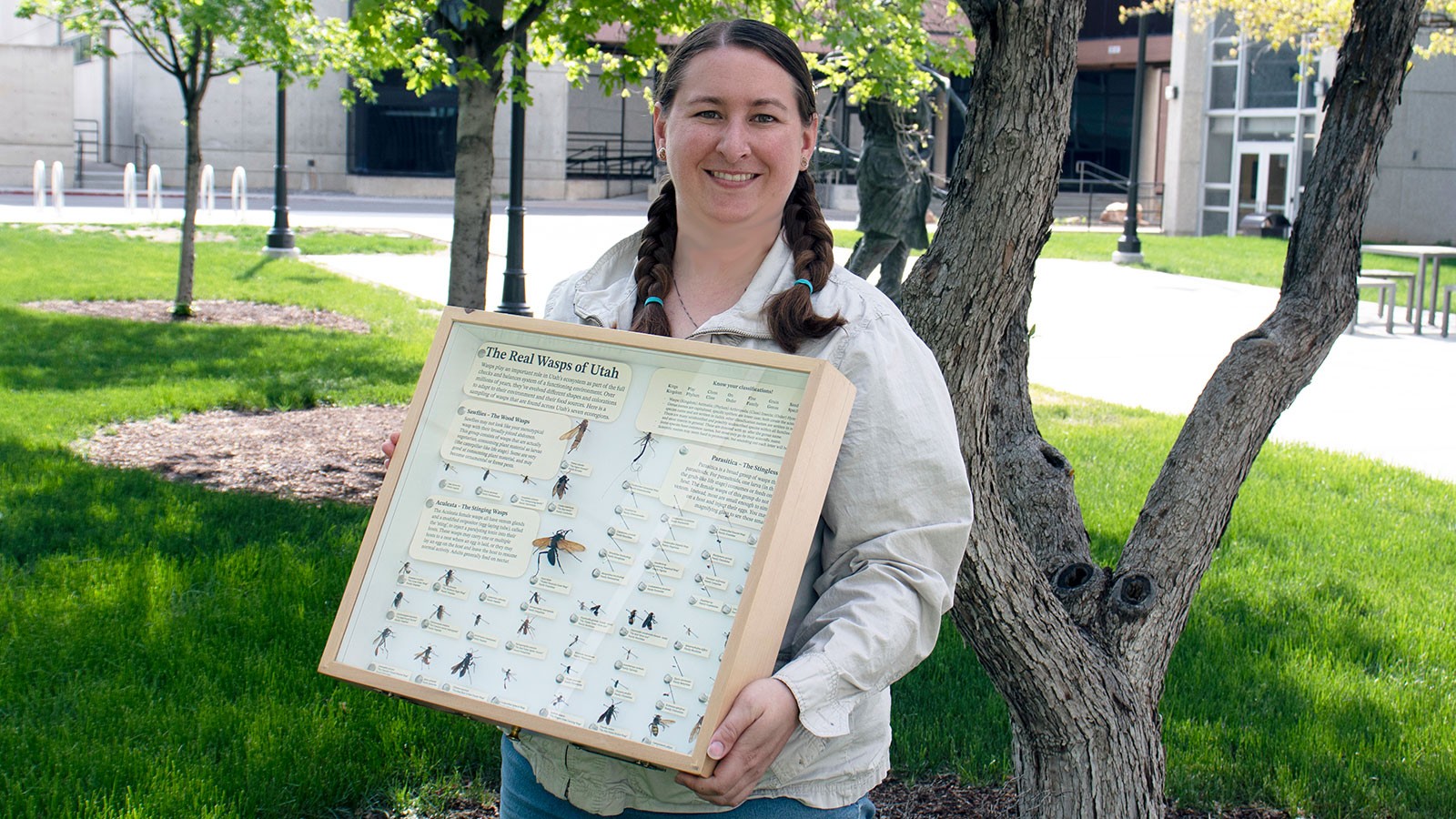'Wasps Are Your Friends': USU Doctoral Student Launches 'Wasps of Utah' Traveling Exhibit June 1
Brenna Decker pursues interdisciplinary interests in entomology, museum studies, art and outreach.
By Mary-Ann Muffoletto |
USU Biology doctoral student Brenna Decker displays wasp specimens that are part of her 'Wasps of Utah' traveling exhibit debuting June 1 at the Bear River Migratory Bird Refuge in Brigham City, Utah. (Photo Credit: USU/M. Muffoletto)
With their painful stings, wasps incite fear in most people. While it may be prudent to avoid direct contact with the flying insects, Utah State University scholar Brenna Decker says the creatures actually provide a range of beneficial services to humans and the environment. She’s on a mission to help Utahns become better acquainted with their winged neighbors and appreciative of their unique beauty.
“My goal is to demystify wasps and to give people an opportunity to observe these insects up close,” says Decker, a doctoral student in the Department of Biology. “When you’re startled by a wasp in the course of your day, you don’t get a chance to study them carefully. With this exhibit, you can take your time examining their unique features.”
Drawing on her broad interests in entomology, art, teaching and museum studies, Decker has crafted a traveling Wasps of Utah exhibit featuring specimens of the state’s insects. The exhibit will make its public debut June 1 at the Bear River Migratory Bird Refuge in Brigham City, Utah.
In addition to wasp specimens, the exhibit includes facts about the insects, such as how wasps are defined, their interactions with humans, where they live, services they provide to humans and the environment, as well as their specializations. The exhibit also includes art created by two recent USU graduates.
Wasps, Decker says, are your friends.
“Many wasps are parasitoids, meaning their larvae live as parasites that eventually kill their hosts,” she says. “Those hosts include agricultural pests that can harm crops and livestock. In this way, wasps can help protect the environment from overuse of pesticides.”
In addition to removing pests that feed on your food supply, wasps, she says, can take out pests that are bugging you directly — like spiders, crickets and flies.
“You might be anxious about wasps buzzing around your home, but they’re ridding you of other pests, including venomous spiders or pesky flies, that might cause you even greater anxiety or harm,” Decker says. “Some wasps are also really good predators and scavengers, further serving as part of the checks and balances system that maintains a healthy ecosystem.”
Their other beneficial qualities? Wasps are pollinators.
“Unlike bees, wasps don’t have specialized branched hairs to hold pollen on their heads and body,” Decker says. “But adult wasps can still transfer pollen between flowers as they feed on nectar.”
Wasps, though intimidating to many, are also beautiful, she says.
“Wasps exist in a range of unique colorations, providing artistic inspiration,” Decker says. “Their exoskeletons feature ridges and pits that reflect light in different wavelengths, yielding wasps of rich blues, greens and purples. Some appear iridescent, with light reflecting off the membranes of their wings.”
Science and art, she says, are “the same thing with different ways of presenting information.”
“’Art’ belongs in ‘STEM’ — that is, ‘STEAM,’” says Decker, who earned undergraduate degrees in art and science. “It’s important to integrate art and science as part of a wholistic approach to education.”
At USU, she combines her passions for science, art, teaching and outreach. With faculty mentor James Pitts, Decker studies the biogeography and behavioral evolution of spider wasps, which belong to the family Pompilidae. She applied for and received the Department of Biology’s Biology-Ecology Award, which provided funding for the development of her wasp exhibit.
Decker has also worked with Molly Cannon, executive director and curator of the USU Museum of Anthropology, and has completed the requirements for a Certificate in Museum Studies through the College of Humanities and Social Sciences. In addition, she served as a teaching assistant in the Department of Biology and earned a Teaching Scholar Certificate through the Empowering Teaching Excellence Office.
A past president and current member of the USU Entomology Club, Decker has led the organization in developing a focus on entomology education and outreach, including participation in USU’s Science Unwrapped, STEM nights at local schools and Insects Tours on and off campus.
Decker’s exhibit will remain at the Bear River Migratory Bird Refuge’s Wildlife Education Center, located at 2155 W. Forest Street (exit 363 from Interstate-15) in Brigham City, until the end of June. From there, it moves to Stokes Nature Center, located about a mile east of the mouth of Logan Canyon, at 2696 E. Highway 89, during the month of July. Decker plans additional exhibit opportunities at locations throughout the state, including USU Extension’s Swaner Preserve and EcoCenter at 1258 Center Drive in Park City, Utah, in Fall 2023.
Decker has also created a virtual Wasps of Utah exhibit, which is available online.
WRITER
Mary-Ann Muffoletto
Public Relations Specialist
College of Science
435-797-3517
maryann.muffoletto@usu.edu
CONTACT
Brenna Decker
Doctoral Student
Department of Biology
815-245-1722
brenna.decker@usu.edu
TOPICS
Biology 165stories STEM 163storiesComments and questions regarding this article may be directed to the contact person listed on this page.







